Hi3559AV100 NNIE开发(5)mobilefacenet.wk仿真成功量化及与CNN_convert_bin_and_print_featuremap.py输出中间层数据对比过程
前面随笔给出了NNIE开发的基本知识,下面几篇随笔将着重于Mobilefacenet NNIE开发,实现mobilefacenet.wk的chip版本,并在Hi3559AV100上实现mobilefacenet网络功能,外接USB摄像头通过MPP平台输出至VO HDMI显示结果。下文是Hi3559AV100 NNIE开发(5)mobilefacenet.wk仿真成功量化及与CNN_convert_bin_and_print_featuremap.py输出中间层数据对比过程,目前实现PC端对mobilefacenet.wk仿真成功量化,为后续在板载chip上加载mobilefacenet.wk输出数据进行比较做准备。
开发环境
操作系统:Windows 10
仿真工具: Ruyi Studio 2.0.28
开发平台: Hi3559AV100
网络模型: Mobilefacenet
框架:Caffe
测试前提
测试前需要搭建好RuyiStudio开发环境,能够正确运行工程,并进行了mobilefacenet 网络训练,生成mobilefacenet.caffemodel,确定好mobilefacenet.prototxt(因为mobilefacenet的所有网络层都是NNIE支持的网络层,所以不需要手动修改、增加或者删除操作,可以通过marked_prototxt中的mark和check操作查看是否正确生成对应的网络结构)。
.wk仿真量化参数配置与测试过程
在测试前先给出NNIE一般量化流程:
(1)需要把其他非caffemodel模型对应转换到caffemodel模型,因为Hi35xx系列NNIE只支持caffemodel模型;
(2)配置仿真量化参数(即配置mobilefacenet.cfg)进行PC仿真量化,获得中间层输出结果A(mapper_quant目录下);
(3)使用RuyiStudio提供的python中间层输出工具,获得中间层输出结果B(data/ouput目录下);
(4)使用Ruyi Studio的向量对比工具Vector Comparison对A和B进行对比,观察误差,使误差控制在一定范围(利用CosineSimilarity参数);
(5)配置板载chip运行量化参数生成mobilefacenet.wk文件,上板运行获得输出结果C;
(6)对比结果A和C,使仿真与板载误差控制在可接受范围内。

创建好工程后,首先配置mobilefacenet.wk文件,需要注意以下几点:
(1)首先选择is_simulation为Simulation进行仿真测试,对比结果正确后再进行Inst/Chip生成板上运行的wk文件。因为mobilefacenet的所有网络层都是NNIE支持的网络层,所以不需要手动修改、增加或者删除操作,可以通过marked_prototxt中的mark和check操作查看是否正确生成对应的网络结构;
(2)log_level = 3可以输出所有中间层的结果,在进行仿真对比调试时应当开启,方便进行向量对比调试;
(3)image_list的设置十分关键,其决定了你实际输入给模型的图片数据是怎么样的。其中image_type默认选择U8,RGB_order表示输入给网络的RGB图像的RGB三通道顺序,norm_type是对图像数据的预处理,这里我们选择channel mean_value with data_scale,对输入图像的数据进行减均值并归一。设置data_scale为0.0078125,即1/128,pixel_mean.txt如下图所示。即让原本[0,255]区间的像素值转换到[-1,1]的区间内。下面给出imageList.txt文本内容:
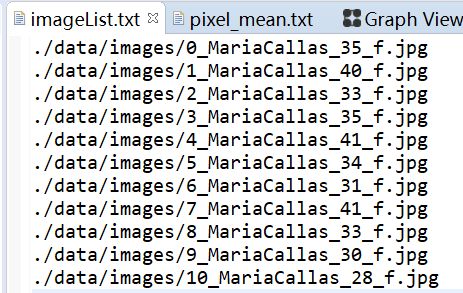
(4)mapper_quant中保存了所有的输出信息,Mobileface_func.wk是生成的仿真wk文件。注意:mapper_quant中保存的输出信息是选择的image_list文件的最后一张图片的输出(这个非常关键,为后面.py输出中间层结果对比的时候确认是哪张图片进行向量数据对比)

给出mobileface.cfg的具体配置:(具体.cfg参数设置可以见:Hi3559AV100 NNIE开发(3)RuyiStudio软件 .wk文件生成过程-mobilefacenet.cfg的参数配置 https://www.cnblogs.com/iFrank/p/14515089.html)
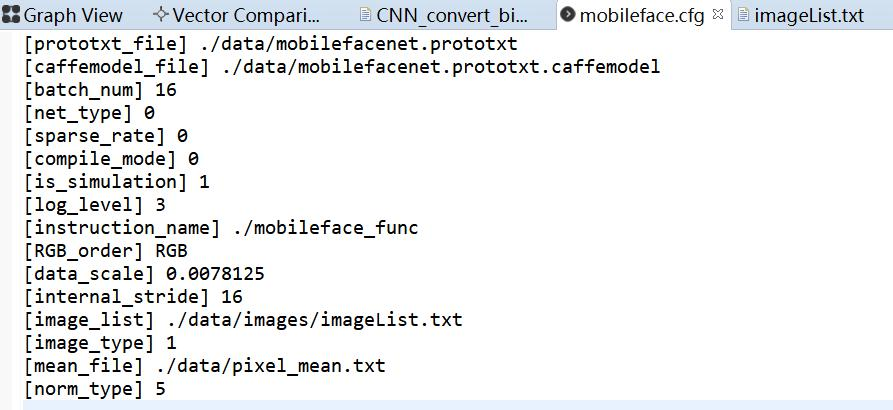
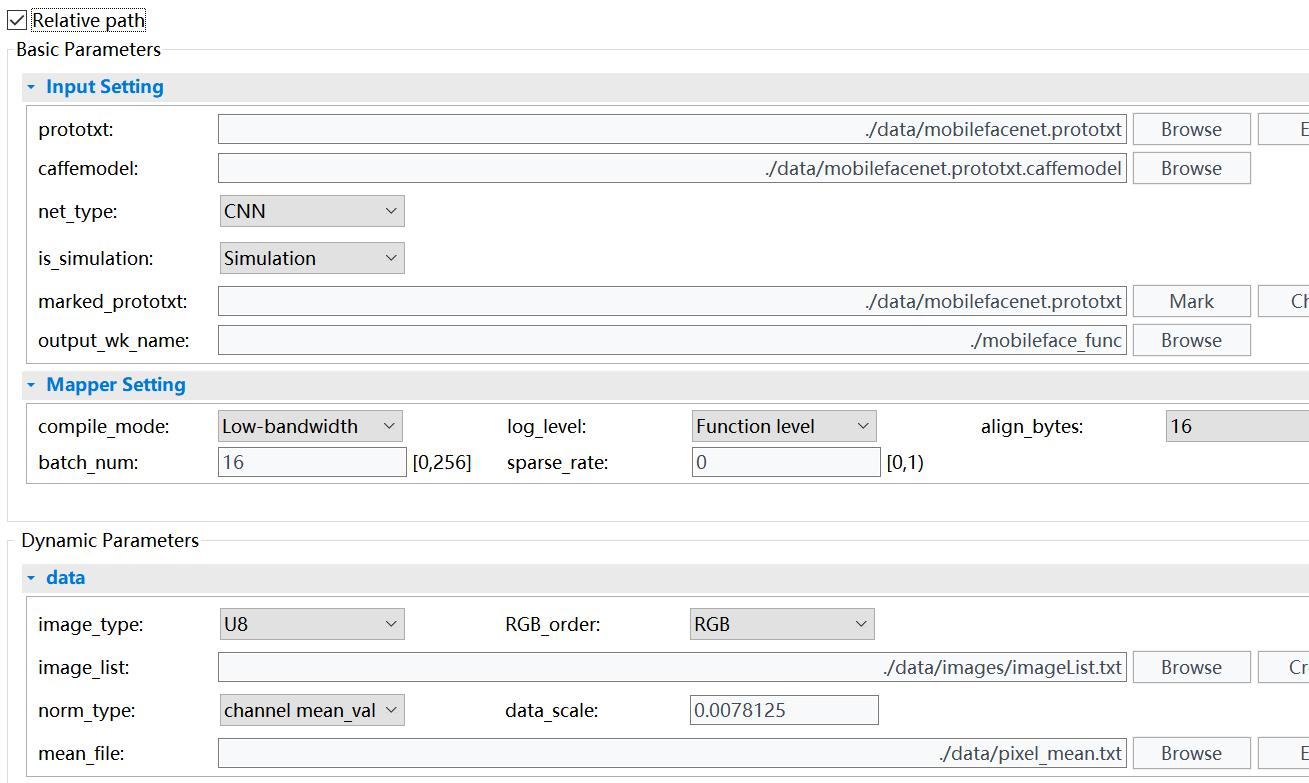
随后点击RuyiStudio软件左上角的make Wk按钮,跳出下面示意图,点击OK即可生成mobileface.wk:
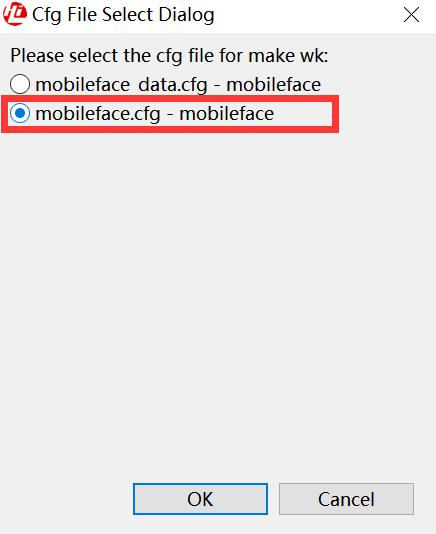
.py输出中间层数据配置与过程
给出CNN_convert_bin_and_print_featuremap.py(RuyiStudio版本为2.0.28):(见此文件放置到mobileface工程data目录下)
1 #from __future__ import print_function
2 import caffe
3 import pickle
4 from datetime import datetime
5 import numpy as np
6 import struct
7 import sys, getopt
8 import cv2, os, re
9 import pickle as p
10 import matplotlib.pyplot as pyplot
11 import ctypes
12 import codecs
13 import caffe.proto.caffe_pb2 as caffe_pb2
14 import google.protobuf as caffe_protobuf
15 import google.protobuf.text_format
16 import platform
17
18 supported_layers=[
19 "Convolution", "Deconvolution", "Pooling", "InnerProduct", "LRN", "BatchNorm", "Scale", "Bias", "Eltwise", "ReLU", "PReLU", "AbsVal", "TanH", "Sigmoid", "BNLL", "ELU", "LSTM", "RNN", "Softmax", "Exp", "Log", "Reshape", "Flattern", "Split", "Slice", "Concat", "SPP", "Power", "Threshold", "MVN", "Parameter", "Reduction", "Proposal", "Custom", "Input", "Dropout"]
20
21 def isSupportedLayer(layer_type):
22 for type in supported_layers:
23 if(layer_type == type):
24 return True
25 return False
26
27
28 def image_to_array(img_file, shape_c_h_w, output_dir):
29 result = np.array([])
30 print("converting begins ...")
31 resizeimage = cv2.resize(cv2.imread(img_file), (shape_c_h_w[2],shape_c_h_w[1]))
32 b,g,r = cv2.split(resizeimage )
33 height, width, channels = resizeimage.shape
34 length = height*width
35 #print(channels )
36 r_arr = np.array(r).reshape(length)
37 g_arr = np.array(g).reshape(length)
38 b_arr = np.array(b).reshape(length)
39 image_arr = np.concatenate((r_arr, g_arr, b_arr))
40 result = image_arr.reshape((1, length*3))
41 print("converting finished ...")
42 file_path = os.path.join(output_dir, "test_input_img_%d_%d_%d.bin"%(channels,height,width))
43 with open(file_path, mode='wb') as f:
44 p.dump(result, f)
45 print("save bin file success")
46
47 def image_to_rgb(img_file,shape_c_h_w, output_dir):
48 print("converting begins ...")
49 #image = cv2.imread(img_file)
50 image = cv2.imdecode(np.fromfile(img_file, dtype=np.uint8), 1)
51 image = cv2.resize(image, (shape_c_h_w[2],shape_c_h_w[1]))
52 image = image.astype('uint8')
53 height = image.shape[0]
54 width = image.shape[1]
55 channels = image.shape[2]
56 file_path = os.path.join(output_dir, "test_input_img_%d_%d_%d.rgb"%(channels,height,width))
57 fileSave = open(file_path,'wb')
58 for step in range(0,height):
59 for step2 in range (0, width):
60 fileSave.write(image[step,step2,2])
61 for step in range(0,height):
62 for step2 in range (0, width):
63 fileSave.write(image[step,step2,1])
64 for step in range(0,height):
65 for step2 in range (0, width):
66 fileSave.write(image[step,step2,0])
67
68 fileSave.close()
69 print("converting finished ...")
70
71 def image_to_bin(img_file,shape_c_h_w, output_dir):
72 print("converting begins ...")
73 #image = cv2.imread(img_file)
74 image = cv2.imdecode(np.fromfile(img_file, dtype=np.uint8), 1)
75 image = cv2.resize(image, (shape_c_h_w[2],shape_c_h_w[1]))
76 image = image.astype('uint8')
77 height = image.shape[0]
78 width = image.shape[1]
79 channels = image.shape[2]
80 file_path = os.path.join(output_dir, "test_input_img_%d_%d_%d.bin"%(channels,height,width))
81 fileSave = open(file_path,'wb')
82 for step in range(0,height):
83 for step2 in range (0, width):
84 fileSave.write(image[step,step2,2])
85 for step in range(0,height):
86 for step2 in range (0, width):
87 fileSave.write(image[step,step2,1])
88 for step in range(0,height):
89 for step2 in range (0, width):
90 fileSave.write(image[step,step2,0])
91
92 fileSave.close()
93 print("converting finished ...")
94
95 def image_to_bgr(img_file,shape_c_h_w, output_dir):
96 print("converting begins ...")
97 #image = cv2.imread(img_file)
98 #print(shape_c_h_w[2])
99 #print(shape_c_h_w[1])
100 image = cv2.imdecode(np.fromfile(img_file, dtype=np.uint8), -1)
101 image = cv2.resize(image, (shape_c_h_w[2],shape_c_h_w[1]))
102 image = image.astype('uint8')
103 b,g,r = cv2.split(image)
104 height = image.shape[0]
105 width = image.shape[1]
106 channels = image.shape[2]
107 file_path = os.path.join(output_dir, "test_input_img_%d_%d_%d.bgr"%(channels,height,width))
108 fileSave = open(file_path,'wb')
109 for step in range(0,height):
110 for step2 in range (0, width):
111 fileSave.write(b[step,step2])
112 for step in range(0,height):
113 for step2 in range (0, width):
114 fileSave.write(g[step,step2])
115 for step in range(0,height):
116 for step2 in range (0, width):
117 fileSave.write(r[step,step2])
118
119 fileSave.close()
120 print("converting finished ...")
121
122 def bin_to_image(bin_file,shape_c_h_w):
123 #fileReader = open(bin_file,'rb', encoding='utf-8')
124 if(platform.system()=="Linux"):
125 fileReader = open(bin_file,'rb')
126 else:
127 fileReader = open(bin_file.encode('gbk'),'rb')
128 height = shape_c_h_w[1]
129 width = shape_c_h_w[2]
130 channel = shape_c_h_w[0]
131 imageRead = np.zeros((shape_c_h_w[1], shape_c_h_w[2], shape_c_h_w[0]), np.uint8)
132 for step in range(0,height):
133 for step2 in range (0, width):
134 a = struct.unpack("B", fileReader.read(1))
135 imageRead[step,step2,2] = a[0]
136 for step in range(0,height):
137 for step2 in range (0, width):
138 a = struct.unpack("B", fileReader.read(1))
139 imageRead[step,step2,1] = a[0]
140 for step in range(0,height):
141 for step2 in range (0, width):
142 a = struct.unpack("B", fileReader.read(1))
143 imageRead[step,step2,0] = a[0]
144 fileReader.close()
145 return imageRead
146
147 def isfloat(value):
148 try:
149 float(value)
150 return True
151 except ValueError:
152 return False
153
154
155 def get_float_numbers(floatfile):
156 mat = []
157 if(platform.system()=="Linux"):
158 with open(floatfile, 'rb') as input_file:
159 for line in input_file:
160 line = line.strip()
161 for number in line.split():
162 if isfloat(number):
163 mat.append(float(number))
164 else:
165 with open(floatfile.encode('gbk'), 'rb') as input_file:
166 for line in input_file:
167 line = line.strip()
168 for number in line.split():
169 if isfloat(number):
170 mat.append(float(number))
171 return mat
172
173 def isHex(value):
174 try:
175 int(value,16)
176 return True
177 except ValueError:
178 return False
179
180 def isHex_old(value):
181 strvalue=str(value)
182 length = len(strvalue)
183 if length == 0:
184 return False
185 i = 0
186 while(i < length):
187 if not (strvalue[i] >= 'a' and strvalue[i] <= 'e' or strvalue[i] >= 'A' and strvalue[i] <= 'E' or strvalue[i] >= '0' and strvalue[i] <= '9'):
188 return False
189 i += 1
190 return True
191
192 def get_hex_numbers(hexfile):
193 mat = []
194 if(platform.system()=="Linux"):
195 with open(hexfile) as input_file:
196 for line in input_file:
197 line = line.strip()
198 for number in line.split():
199 if isHex(number):
200 mat.append(1.0*ctypes.c_int32(int(number,16)).value/4096)
201 else:
202 with open(hexfile.encode("gbk")) as input_file:
203 for line in input_file:
204 line = line.strip()
205 for number in line.split():
206 if isHex(number):
207 mat.append(1.0*ctypes.c_int32(int(number,16)).value/4096)
208 return mat
209
210 def print_CNNfeaturemap(net, output_dir):
211 params = list(net.blobs.keys())
212 print (params)
213 for pr in params[0:]:
214 print (pr)
215 res = net.blobs[pr].data[...]
216 pr = pr.replace('/', '_')
217 pr = pr.replace('-', '_')
218 print (res.shape)
219 for index in range(0,res.shape[0]):
220 if len(res.shape) == 4:
221 filename = os.path.join(output_dir, "%s_output%d_%d_%d_%d_caffe.linear.float"%(pr,index,res.shape[1],res.shape[2],res.shape[3]))
222 elif len(res.shape) == 3:
223 filename = os.path.join(output_dir, "%s_output%d_%d_%d_caffe.linear.float"%(pr, index,res.shape[1],res.shape[2]))
224 elif len(res.shape) == 2:
225 filename = os.path.join(output_dir, "%s_output%d_%d_caffe.linear.float"%(pr,index,res.shape[1]))
226 elif len(res.shape) == 1:
227 filename = os.path.join(output_dir, "%s_output%d_caffe.linear.float"%(pr,index))
228 f = open(filename, 'wb')
229
230 np.savetxt(f, list(res.reshape(-1, 1)))
231
232 # save result by layer name
233 def save_result(train_net, net, output_dir):
234 #logging.debug(net_param)
235 max_len = len(train_net.layer)
236
237 # input data layer
238 index = 0
239 for input in train_net.input:
240 layer_data = net.blobs[input].data[...]
241 layer_name=input.replace("/", "_")
242 layer_name=input.replace("-", "_")
243 shape_str= str(layer_data.shape)
244 shape_str=shape_str[shape_str.find(", ") + 1:].replace("(", "").replace(")", "").replace(" ", "").replace(",", "_")
245 filename = os.path.join(output_dir, "%s_output%d_%s_caffe.linear.float"%(layer_name, index, shape_str))
246 np.savetxt(filename, layer_data.reshape(-1, 1))
247 index = index + 1
248 # other layer
249 i = 0
250 for layer in train_net.layer:
251 index = 0
252 for top in layer.top:
253 # ignore inplace layer
254 if 1 == len(layer.top) and 1 == len(layer.bottom) and layer.top[0] == layer.bottom[0]:
255 break
256 layer_data = net.blobs[top].data[...]
257 layer_name=layer.name.replace("/", "_")
258 layer_name=layer.name.replace("-", "_")
259 shape_str= str(layer_data.shape)
260 shape_str=shape_str[shape_str.find(", ") + 1:].replace("(", "").replace(")", "").replace(" ", "").replace(",", "_")
261 filename = os.path.join(output_dir, "%s_output%d_%s_caffe.linear.float"%(layer_name, index, shape_str))
262 np.savetxt(filename, layer_data.reshape(-1, 1))
263 index = index + 1
264 # update the process_bar
265 i = i + 1
266 k = i * 100 / max_len
267 process_str = ">" * int(k) + " " * (100 - int(k))
268 sys.stdout.write('\r'+ process_str +'[%s%%]'%(k))
269 sys.stdout.flush()
270 sys.stdout.write("\n")
271 sys.stdout.flush()
272
273 def main(argv):
274 if len(argv) < 6:
275 print ('CNN_convert_bin_and_print_featuremap.py -m <model_file> -w <weight_file> -i <img_file or bin_file or float_file> -p <"104","117","123" or "ilsvrc_2012_mean.npy">')
276 print ('-m <model_file>: .prototxt, batch num should be 1')
277 print ('-w <weight_file>: .caffemodel')
278 print ('-i <img_file>: .JPEG or jpg or png or PNG or bmp or BMP')
279 print ('-i <bin_file>: test_img_$c_$h_$w.bin')
280 print ('-i <float_file>: %s_output%d_%d_%d_%d_caffe.linear.float')
281 print ('-n <norm_type>: 0(default): no process, 1: sub img-val and please give the img path in the parameter p, 2: sub channel mean value and please give each channel value in the parameter p in BGR order, 3: dividing 256, 4: sub mean image file and dividing 256, 5: sub channel mean value and dividing 256')
282 print ('-s <data_scale>: optional, if not set, 0.003906 is set by default')
283 print ('-p <"104", "117", "123" or "ilsvrc_2012_mean.npy" or "xxx.binaryproto">: -p "104", "117", "123" is sub channel-mean-val, -p "ilsvrc_2012_mean.npy" is sub img-val and need a ilsvrc_2012_mean.npy')
284 print ('-o <output_dir: optional, if not set, there will be a directory named output created in current dir>')
285 print ('-c <0 or 1> 1, gpu, 0 cpu')
286 print ('any parameter only need one input')
287
288 sys.exit(2)
289 norm_type = 0
290 data_scale = 0.003906
291 output_dir = 'output/'
292 opts, args = getopt.getopt(argv, "hm:w:i:n:s:p:o:c:")
293 cuda_flag = 0
294 for opt, arg in opts:
295 if opt == '-h':
296 print ('CNN_convert_bin_and_print_featuremap.py -m <model_file> -w <weight_file> -i <img_file or bin_file or float_file> -p <"104","117","123" or "ilsvrc_2012_mean.npy">')
297 print ('-m <model_file>: .prototxt, batch num should be 1')
298 print ('-w <weight_file>: .caffemodel')
299 print ('-i <img_file>: .JPEG or jpg or png or PNG or bmp or BMP')
300 print ('-i <bin_file>: test_img_$c_$h_$w.bin')
301 print ('-i <float_file>: %s_output%d_%d_%d_%d_caffe.linear.float')
302 print ('-n <norm_type>: 0(default): no process, 1: sub img-val and please give the img path in the parameter p, 2: sub channel mean value and please give each channel value in the parameter p in BGR order, 3: dividing 256, 4: sub mean image file and dividing 256, 5: sub channel mean value and dividing 256')
303 print ('-s <data_scale>: optional, if not set, 0.003906 is set by default')
304 print ('-p <"104", "117", "123", "ilsvrc_2012_mean.npy" or "xxx.binaryproto">: -p "104", "117", "123" is sub channel-mean-val, -p "ilsvrc_2012_mean.npy" is sub img-val and need a ilsvrc_2012_mean.npy')
305 print ('-o <output_dir: optional, if not set, there will be a directory named output created in current dir>')
306 print ('-c <0 or 1> 1, gpu, 0 cpu')
307 print ('any parameter only need one input')
308
309 sys.exit()
310 elif opt == "-m":
311 model_filename = arg
312 elif opt == "-w":
313 weight_filename = arg
314 elif opt == "-i":
315 img_filename = arg
316 elif opt == "-n":
317 norm_type = arg
318 elif opt == "-s":
319 data_scale = arg
320 elif opt == "-o":
321 output_dir = arg
322 elif opt == "-p":
323 meanfile = arg # default is to divide by 255
324 initialway = "sub mean by: " + meanfile
325 elif opt == "-c":
326 cuda_flag = arg
327
328 if('1' == cuda_flag):
329 caffe.set_mode_gpu()
330 caffe.set_device(0)
331
332 train_net = caffe_pb2.NetParameter()
333 if(platform.system()=="Linux"):
334 f=open(model_filename, 'rb')
335 else:
336 f=open(model_filename.encode('gbk'), 'rb')
337
338 train_str = f.read()
339 caffe_protobuf.text_format.Parse(train_str, train_net)
340 f.close()
341 layers = train_net.layer
342
343 for layer in layers:
344 if(False == isSupportedLayer(layer.type)):
345 print("Layer " + layer.name + " with type " + layer.type + " is not supported, please refer to chapter 3.1.4 and FAQ of \"HiSVP Development Guide.pdf\" to extend caffe!")
346 sys.exit(1)
347 print ('model file is ', model_filename)
348 print ('weight file is ', weight_filename)
349 print ('image file is ', img_filename)
350 print ('image preprocessing method is ', norm_type) # default is no process
351 print ('output dir is ', output_dir)
352 print ('data scale is ', data_scale)
353 if(platform.system()=="Linux"):
354 net = caffe.Net(model_filename, weight_filename, caffe.TEST)
355 else:
356 net = caffe.Net(model_filename.encode('gbk'), weight_filename.encode('gbk'), caffe.TEST)
357
358 print ('model load success')
359
360 if norm_type == '1' or norm_type == '4':
361 if not os.path.isfile(meanfile):
362 print("Please give the mean image file path")
363 sys.exit(1)
364 if meanfile.endswith('.binaryproto'):
365 meanfileBlob = caffe.proto.caffe_pb2.BlobProto()
366 if(platform.system()=="Linux"):
367 meanfileData = open(meanfile, 'rb').read()
368 else:
369 meanfileData = open(meanfile.encode('gbk'), 'rb').read()
370 meanfileBlob.ParseFromString(meanfileData)
371 arr = np.array(caffe.io.blobproto_to_array(meanfileBlob))
372 out = arr[0]
373 np.save('transMean.npy', out)
374 meanfile = 'transMean.npy'
375
376 print ('model file is ', model_filename)
377 print ('weight file is ', weight_filename)
378 print ('image file is ', img_filename)
379 print ('image preprocessing method is ', norm_type) # default is no process
380 print ('output dir is ', output_dir)
381 print ('data scale is ', data_scale)
382
383 if not os.path.isdir(output_dir):
384 os.mkdir(output_dir)
385
386 if img_filename.endswith('.jpg') or img_filename.endswith('.png') or img_filename.endswith('.jpeg') or img_filename.endswith('.bmp') or img_filename.endswith('.JPEG') or img_filename.endswith('.PNG') or img_filename.endswith('.JPG') or img_filename.endswith('.BMP'):
387
388 image_to_bin(img_filename, net.blobs['data'].data.shape[1:], output_dir)
389 if net.blobs['data'].data.shape[1]==1:
390 color = False
391 elif net.blobs['data'].data.shape[1]==3:
392 image_to_rgb(img_filename, net.blobs['data'].data.shape[1:], output_dir)
393 image_to_bgr(img_filename, net.blobs['data'].data.shape[1:], output_dir)
394 color = True
395 img = cv2.imdecode(np.fromfile(img_filename, dtype=np.uint8), -1)
396 #img = cv2.cvtColor(img, cv2.COLOR_BGR2RGB) #add here
397 inputs = img
398 elif img_filename.endswith('.bin'):
399 if(platform.system()=="Linux"):
400 fbin = open(img_filename)
401 else:
402 fbin = open(img_filename.encode('gbk'))
403 data = bin_to_image(img_filename,net.blobs['data'].data.shape[1:])
404 inputs = data
405 elif img_filename.endswith('.float'):
406 data = np.asarray(get_float_numbers(img_filename))
407 inputs = data
408 inputs= np.reshape(inputs, net.blobs[list(net.blobs.keys())[0]].data.shape)
409 elif img_filename.endswith('.hex'):
410 data = np.asarray(get_hex_numbers(img_filename))
411 inputs = data
412 inputs= np.reshape(inputs,net.blobs[list(net.blobs.keys())[0]].data.shape)
413 else:
414 print("errors: unknown input file!")
415 sys.exit(1)
416
417 if len(inputs):
418 transformer = caffe.io.Transformer({'data': net.blobs['data'].data.shape})
419 if net.blobs['data'].data.shape[1]==3:
420 transformer.set_transpose('data', (2,0,1))
421 if norm_type == '1' or norm_type == '4' and os.path.isfile(meanfile): # (sub mean by meanfile):
422 if net.blobs['data'].data.shape[1]==3:
423 transformer.set_mean('data',np.load(meanfile).mean(1).mean(1))
424 elif net.blobs['data'].data.shape[1]==1:
425 tempMeanValue = np.load(meanfile).mean(1).mean(1)
426 tempa = list(tempMeanValue)
427 inputs = inputs - np.array(list(map(float, [tempa[0]])))
428 elif norm_type == '2' or norm_type == '5':
429 if net.blobs['data'].data.shape[1]==3:
430 lmeanfile=meanfile.split(',')
431 if len(lmeanfile) != 3:
432 print("Please give the channel mean value in BGR order with 3 values, like 112,113,120")
433 sys.exit(1)
434 if not isfloat(lmeanfile[0]) or not isfloat(lmeanfile[1]) or not isfloat(lmeanfile[2]):
435 print("Please give the channel mean value in BGR order")
436 sys.exit(1)
437 else:
438 transformer.set_mean('data',np.array(list(map(float,re.findall(r'[-+]?\d*\.\d+|\d+',meanfile)))))
439 elif net.blobs['data'].data.shape[1]==1:
440 lmeanfile=meanfile.split(',')
441 if isfloat(lmeanfile[0]): # (sub mean by channel)
442 inputs = inputs - np.array(list(map(float, [lmeanfile[0]])))
443
444 elif norm_type == '3':
445 inputs = inputs * float(data_scale)
446 if img_filename.endswith('.txt') or img_filename.endswith('.float') or img_filename.endswith('.hex'):
447 print (inputs.shape)
448 data = inputs
449 else:
450 data = np.asarray([transformer.preprocess('data', inputs)])
451 if norm_type == '4' or norm_type == '5':
452 data = data * float(data_scale)
453
454 data_reshape= np.reshape(data,net.blobs[list(net.blobs.keys())[0]].data.shape)
455 net.blobs[list(net.blobs.keys())[0]].data[...] = data_reshape.astype('float')
456 out = net.forward()
457 save_result(train_net, net, output_dir)
458 #print_CNNfeaturemap(net, output_dir)
459 sys.exit(0)
460 if __name__=='__main__':
461 main(sys.argv[1:])
cmder输入命令:(在mobilefacenet/data目录下)运行结束后会在data文件夹下生成一个output文件夹,其中存储了中间层输出结果B。
python CNN_convert_bin_and_print_featuremap.py -i .\images\10_MariaCallas_28_f.jpg -m mobilefacenet.prototxt -w mobilefacenet.prototxt.caffemodel -s 0.0078125 -n 5 -p "128","128","128"
中间层数据比较文件配置与结果
点击Vector Comparision,配置如下:

配置注意事项:
(1)Parse Dot File选择主目录下的cnn_net_tree.dot,Prototxt File为data目录下的mobilefacenet.prototxt;
(2)Left Folder和Right Folder分别选择mapper_quant文件夹和data/output文件夹;
(3)等待数据加载完成后点击compare即可开始对比;
测试结果:通过Vector Comparison进行数据对比,可以发现量化成功了,最终输出结果为0.991,然后中间有些层偏差比较大,怀疑可能是NNIE的层处理与caffe有所不同,这种误差可能可以通过merge_batchnorm操作消除,具体如下:

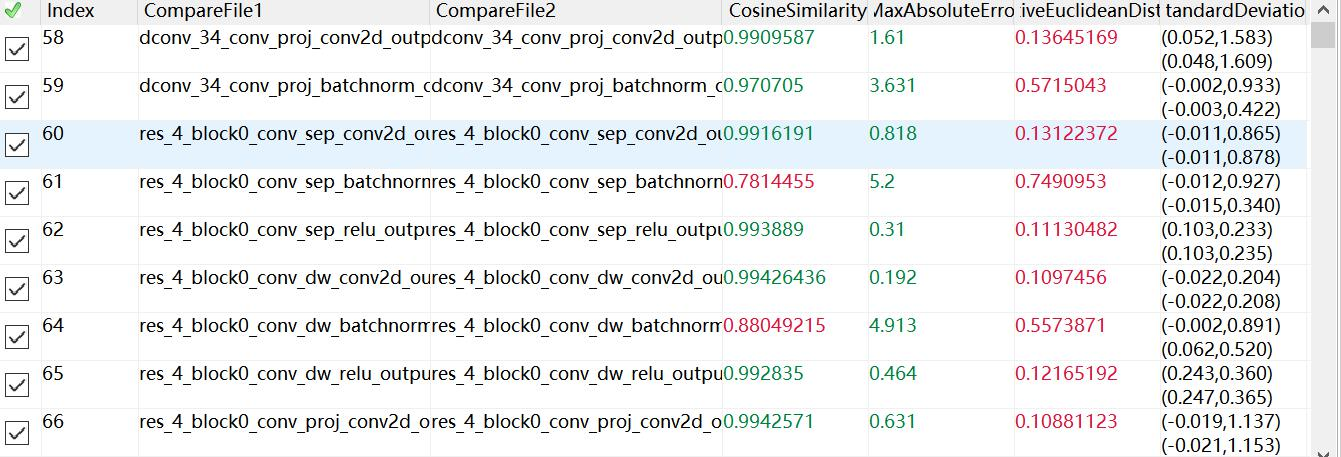


Hi3559AV100 NNIE开发(5)mobilefacenet.wk仿真成功量化及与CNN_convert_bin_and_print_featuremap.py输出中间层数据对比过程的更多相关文章
- Hi3559AV100 NNIE开发(7) Ruyistudio 输出mobileface_func.wk与板载运行mobileface_chip.wk输出中间层数据对比
前面随笔讲了关于NNIE的整个开发流程,并给出了Hi3559AV100 NNIE开发(5)mobilefacenet.wk仿真成功量化及与CNN_convert_bin_and_print_featu ...
- Hi3559AV100 NNIE开发(3)RuyiStudio软件 .wk文件生成过程-mobilefacenet.cfg的参数配置
之后随笔将更多笔墨着重于NNIE开发系列,下文是关于Hi3559AV100 NNIE开发(3)RuyiStudio软件 .wk文件生成过程-mobilefacenet.cfg的参数配置,目前项目需要对 ...
- Hi3559AV100 NNIE开发(4)mobilefacenet.cfg参数配置挖坑解决与SVP_NNIE_Cnn实现分析
前面随笔给出了NNIE开发的基本知识,下面几篇随笔将着重于Mobilefacenet NNIE开发,实现mobilefacenet.wk的chip版本,并在Hi3559AV100上实现mobilefa ...
- Hi3559AV100 NNIE开发(2)-RFCN(.wk)LoadModel及NNIE Init函数运行过程分析
之后随笔将更多笔墨着重于NNIE开发系列,下文是关于Hi3559AV100 NNIE开发(2)-RFCN(.wk)LoadModel及NNIE Init函数运行过程分析,通过对LoadModel函数及 ...
- Hi3559AV100 NNIE开发(6)RFCN中NNIE实现关键线程函数->SAMPLE_SVP_NNIE_Rfcn_ViToVo()进行数据流分析
前面随笔给出了NNIE开发的基本知识,下面几篇随笔将着重于Mobilefacenet NNIE开发,实现mobilefacenet.wk的chip版本,并在Hi3559AV100上实现mobilefa ...
- 基于Hi3559AV100的SVP(NNIE)开发整体流程
在之后的hi3559AV100板载开发中,除了走通V4L2->VDEC->VPSS->VO(HDMI)输出,还有需要进行神经网络的开发学习,进行如face detection的开发等 ...
- Hi3559AV100 NNIE RFCN开发:V4L2->VDEC->VPSS->NNIE->VGS->VO系统整体动态调试实现
下面随笔将给出Hi3559AV100 NNIE RFCN开发:V4L2->VDEC->VPSS->NNIE->VGS->VO系统整体动态调试实现,最终的效果是:USB摄像 ...
- Hi3359AV100 NNIE开发(1)-RFCN demo LoadModel函数与参数解析
之后随笔将更多笔墨着重于NNIE开发系列,下文是关于Hi3359AV100 NNIE开发(1)-RFCN demo LoadModel函数与参数解析,通过对LoadModel函数的解析,能够很好理解. ...
- lua----------------使用VS2015搭建lua开发环境的一些侥幸成功经验,
所以本篇博文介绍在Windows平台下,使用VS2015搭建lua开发环境的一些侥幸成功经验,安装过程参考网上教程,安装过程如下(参考http://www.byjth.com/lua/33.html) ...
随机推荐
- K8S(08)交付实战-交付jenkins到k8s集群
k8s交付实战-交付jenkins到k8s集群 目录 k8s交付实战-交付jenkins到k8s集群 1 准备jenkins镜像 1.1 下载官方镜像 1.2 修改官方镜像 1.2.1 创建目录 1. ...
- Xtrabackup 物理备份
目录 Xtrabackup 安装 Xtrabackup 备份介绍 Xtrabackup全量备份 准备备份目录 全量备份 查看全量备份内容 Xtrabackup 全量备份恢复数据 删除所有数据库 停止数 ...
- Chapter Zero 0.2.2 内存
目录 内存 内存的多通道设计 DRAM 和 SRAM 只读存储器(ROM) RAM.ROM以及硬盘的区别(转自百度) 内存 CPU的数据都是来自主存储器(main memory),个人计算机的主寄存器 ...
- 使用dotNET_Reactor4.7加密后的dll在VS2010中无法打包
1.只要去除加密工具中的反编译选项"Anti ILDASM",再加密就OK了. 2.或者使用VS2008打包也行.
- Sublime text 3 中 Package Control安装
安装前 ctrl+shift+p 在命令板中输入PC,如下图表示没安装: 使用ctrl+~调出sublime软件的控制台命令窗口:粘贴运行 import urllib.request,os,hash ...
- Ajax 实战大全!
1.html 文件 ( form.html) 1 <!DOCTYPE HTML> 2 <html> 3 <head> 4 <meta http-equiv=& ...
- 微软官方 free 教程 & 教材 ,MVC ,ASP.NET,.NET,
MVA https://mva.microsoft.com/ebooks free ebooks 微软官方, free, 教程 ,教材,微软官方 free 教程 & 教材,MVC ,ASP.N ...
- LeetCode 算法面试题汇总
LeetCode 算法面试题汇总 算法面试题 https://leetcode-cn.com/problemset/algorithms/ https://leetcode-cn.com/proble ...
- PyCharm 中文 字符 python 报错 的 完美 解决方案!
PyCharm 中文 字符 python 报错 的 完美 解决方案! #_*_ coding:utf-8_*_ https://www.python.org/dev/peps/pep-0263/ 到p ...
- ES6 Generator vs ES6 async/await
ES6 Generator vs ES6 async/await next yield promise refs xgqfrms 2012-2020 www.cnblogs.com 发布文章使用:只允 ...
